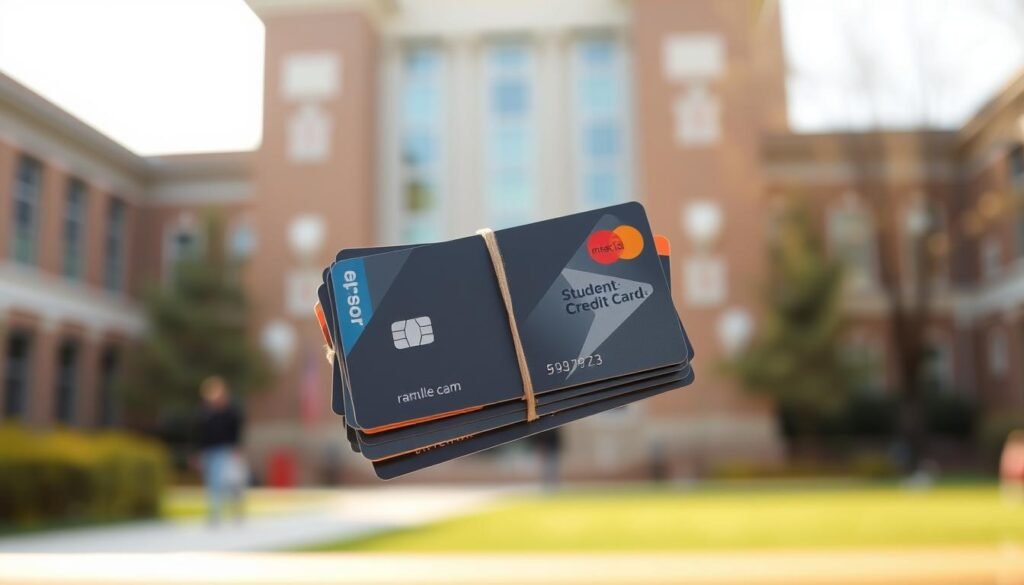
Best Student Credit Cards USA 2026: Top Picks for You

You arrive at campus with a suitcase, a syllabus, and a mix of hope and worries about money. I remember that tension wondering how to pay for groceries, gas, or a flight home without wrecking your future finances.
This guide meets you where you are. It walks through practical options from Discover, Capital One, Bank of America, and Prime Visa so you can match a card to your daily life, rewards habits, and long-term goals.
You’ll learn how simple moves on-time payments and low fees help build credit and shape a stronger credit history and score over time.
Later sections break down fees, rewards like rotating 5% categories or flat 1.5% cash back, secured paths to an unsecured line, and clear steps to avoid interest.
Start here and feel confident that each choice supports your budget and future borrowing power.
- Why student credit cards matter in 2026 for your credit journey
- Editor’s methodology: how we chose the best student credit cards
- Best student credit cards USA 2026: the shortlist
- Side‑by‑side comparison table: rewards, fees, intro APRs, and perks
- Deep dives: our top card picks and who each is best for
- How to pick the right student card for your budget and goals
- Approval strategy for students: improve your odds before you apply
- Build credit the smart way: practical steps to raise your score
- Action plan and useful resources to keep you on track
- Your next step toward great credit and the right card
Why student credit cards matter in 2026 for your credit journey
Starting a credit file while you're in college gives you a head start on future loans, rentals, and job screenings.
Payment history reported to Equifax, Experian, and TransUnion is the single biggest driver of a healthy score. When you open a student credit card and pay the bill on time, those on-time marks build your credit history and help you qualify for lower rates on auto loans or a mortgage later.
Understand APR in simple terms: it's the interest rate charged when you carry a balance past the grace period. Average card interest hovered near 20% in 2024, and 0% intro APRs are temporary they revert to a variable APR, so plan to pay off purchases before the promotional period ends.

Fees, rewards, and age rules made clear
Annual fees, late fees, and foreign transaction fees can add up. No-annual-fee options are often best when you’re learning to manage a card.
Rewards come as cash back, points, or rotating categories. Pick a rewards structure that matches your spending so the benefit matters to you.
Quick example and a simple checklist
Example: Paying the full statement balance avoids interest entirely. Making only the minimum payment lets interest compound and raises the cost month after month.
- Automate monthly payments to avoid late marks.
- Keep utilization low by spending within a budget.
- Review statements each month and verify bureau data (Equifax, Experian, TransUnion).
- If you’re under 21, learn CARD Act rules on income and consider an authorized user or cosigner path if needed.
| Topic | What to watch | Action |
|---|---|---|
| Payment reporting | On-time payments to three bureaus | Automate payments; check reports yearly |
| APR & interest | Intro APRs end; variable rates apply | Pay full balance before intro ends |
| Fees & rewards | Annual vs. ongoing fees; rewards structure | Choose no annual fee and useful rewards |
| Under 21 rules | CARD Act income/cosigner limits | Use authorized user or cosigner options |
Editor’s methodology: how we chose the best student credit cards
We tested public card disclosures and bureau guidance to craft a scoring method you can trust.

Where our data comes from and what "future" changes mean
We pulled rates and terms directly from issuer product pages and official disclosures (nofollow). That includes listings for Discover, Capital One, Bank of America, Capital One Platinum Secured, and Prime Visa.
Why this matters: issuers update offers and interest rates. We flag current terms and note how future changes can affect long-term value so you avoid chasing short promos.
How we score each card
Our scoring balances practical features you will use:
- Rewards value and category fit for campus life.
- Total fees, including any annual fee and foreign fees.
- Intro APRs, approval odds, and realistic limits for first-time applicants.
- Bureau reporting and whether the card helps build credit history and raise your score.
Transparency and editorial independence
We disclose affiliate links and any earnings. Partners do not influence rankings. Read our editorial approach on studyfinance for full details.
"We verify issuer disclosures and prioritize terms you can act on."
Best student credit cards USA 2026: the shortlist
This quick guide lists compact options you can scan in minutes to match the card to your habits and goals.

Top cash back picks for everyday college spending
- Discover it Student Cash Back - rotating 5% categories and a first-year Cashback Match make this a high-earning choice for planned category spending.
- Capital One Savor Student - steady 3% on dining, entertainment, streaming, and groceries for campus life that leans on experiences.
- Capital One Quicksilver Student - 1.5% flat on every purchase if you prefer simple, predictable rewards without tracking categories.
Standout choices for commuters, study abroad, and flat-rate simplicity
- Discover it Student Chrome - 2% at gas stations and restaurants (up to $1,000 per quarter), then 1%.
- Bank of America Travel Rewards for Students - 1.5x everywhere with no foreign transaction fee, useful for semesters abroad.
- BofA Customized Cash Rewards for Students - switchable 3% category if you want flexible bonus categories.
When a secured card beats a student card
If you need approval with limited history, Capital One Platinum Secured offers low deposit tiers and a path to higher limits after on-time payments. This can be the smarter route until you build enough income or score to qualify for unsecured options.
Next step: use our side-by-side comparison and then check issuer pages for current terms. For budgeting and application guidance, visit studyfinance’s credit cards hub.
Side‑by‑side comparison table: rewards, fees, intro APRs, and perks
See rewards caps, intro APR windows, and foreign fees at a glance to plan big purchases and travel.
Use this compact table to compare reward types (rotating, choice, or flat), quarterly limits, and whether a given credit card charges foreign transaction fees or an annual fee.
Cash back structures vs. rotating or choice categories
| Card | Rewards & caps | Intro APR (months) | Fees / Foreign |
|---|---|---|---|
| Discover it Student Cash Back | 5% rotating (quarterly cap), then 1%; first‑year Cashback Match | 0% on purchases 6 | No annual fee; standard foreign fees apply |
| Discover it Student Chrome | 2% gas & restaurants (up to $1,000/quarter), then 1% | 0% on purchases 6 | No annual fee; standard foreign fees apply |
| Capital One Savor Student | 3% on dining, entertainment, streaming, groceries | — | No annual fee; standard foreign fees apply |
| Capital One Quicksilver Student | 1.5% flat; travel portal boosts possible | — | No annual fee; standard foreign fees apply |
| BofA Customized Cash / Travel / Secured / Prime Visa | 3% choice / 1.5x travel / secured deposit tiers / 5% Amazon (Prime) | 0% up to 15 (Customized / Travel); varies for others | No annual fee for most; Prime Visa needs subscription; some no FX fees |
Quick notes: check caps, limits, and whether balance transfers are included before you apply. For live terms, visit issuer pages and use studyfinance tools to project rewards and protect your credit score by tracking balances monthly.
Deep dives: our top card picks and who each is best for
Below are concise mini‑reviews that pair each card with the real habits you’ll use most.
Discover it Student Cash Back
Who it fits: If you can time purchases to rotating quarters, this one boosts rewards through 5% categories plus a first‑year Cashback Match.
Tip: track quarterly caps and pay in full to avoid interest during the 0% intro period.
Capital One Savor Student
Who it fits: You spend heavily on dining, streaming, and entertainment. A steady 3% makes daily spending simple and rewarding.
Discover it Student Chrome
Who it fits: Commuters who buy gas and grab food out often. The 2% bonus on gas and restaurants maps to real campus budgets.
BofA Customized Cash Rewards for Students
Who it fits: You want flexibility. Switch a 3% category with a $2,500 quarterly cap and use the long 0% intro for big buys.
BofA Travel Rewards for Students
Who it fits: Planning a semester abroad. A flat 1.5x and no foreign fees keeps redemptions simple and travel costs lower.
Capital One Quicksilver Student
Who it fits: You want one flat rate on every purchase. No category juggling and easy rewards stacking with student discounts.
Capital One Platinum Secured
Who it fits: If approval is the hurdle, start here with a refundable deposit and aim to build credit and raise limits after six months.
Prime Visa (with Prime Student)
Who it fits: Heavy Amazon/Whole Foods users who have Prime Student. The 5% back and a signup gift can offset essentials quickly. Confirm eligibility and current terms.
- Quick actions: match categories to your spending, set autopay, and avoid carrying a balance to maximize rewards.
| Card | Key perk | Good for |
|---|---|---|
| Discover it Cash Back | 5% rotating + Cashback Match | Category planners |
| Capital One Savor | 3% dining/entertainment | Frequent diners |
| BofA Travel Rewards | 1.5x, no FX fee | Abroad travel |
How to pick the right student card for your budget and goals
Start by mapping your spending habits so a card rewards what you already buy.
List your regular expenses: dining plans, groceries, gas, online shopping, and travel. If you already have a campus meal plan, a grocery bonus will give you little value.
Compare annual fee versus expected rewards. Most student options waive an annual fee, so focus on category fit and easy-to-use rewards.
When to use 0% intro APR for large buys
0% periods can help for planned purchases like a laptop. Use them only if you budget the monthly payoff.
If you think the promo will stretch your ability to pay, skip it. Carrying a balance past the intro invites interest and raises debt.
Foreign fees and protections for overseas semesters
Check foreign transaction fees before you travel. Cards like BofA Travel Rewards and many Capital One student products often charge no FX fees; verify current terms on issuer pages (nofollow).
Simple selection checklist
- Map monthly spend to reward categories.
- Prefer no annual fee unless rewards clearly exceed it.
- Use 0% APR for planned buys and pay before the promo ends.
- Pick a no-FX card with travel protections for study abroad.
- Keep utilization under 30% and pay on time to build credit history and protect your score.
- If unsure, choose a flat-rate 1.5% card now and switch later as your habits solidify.
| Decision point | What to check | Quick action |
|---|---|---|
| Primary spend | Dining, gas, groceries, travel | Choose card with matching bonus categories |
| Large purchase plan | Length of 0% intro APR (e.g., 6–15 months) | Budget monthly payments; avoid if it increases spending |
| Travel abroad | Foreign transaction fee & travel protections | Pick no-FX card and confirm coverage on issuer site |
Approval strategy for students: improve your odds before you apply
Before you apply, a few targeted steps can sharply raise your approval odds and protect your score.
Start with preapproval checks. Many issuers offer a soft-search preapproval that does not trigger a hard inquiry. Use those tools first, then apply only after you get a positive result to avoid unnecessary hits to your profile.
Know the CARD Act rules on income and age. If you are under 21 and lack independent income, you must show qualifying income or use an authorized user route until you qualify on your own. Prepare W‑2s, stipend statements, or other permitted income documents where allowed.
Paths to access and when to choose each
- Consider becoming an authorized user on a family member’s account to begin building credit history without a primary application.
- If approval is tight, a secured option like Capital One Platinum Secured can help you get credit with a refundable deposit and a path to increases after on‑time payments.
- Cosigners are rare for many cards; if used, agree on repayment rules and set up autopay so one missed payment doesn’t damage both people’s credit score.
Protect your score while you apply
Space applications one at a time. Multiple hard pulls in a short period lower your profile more than a single inquiry.
Keep utilization low from day one. Even a small limit helps if you pay weekly before the statement posts.
| Step | Quick action | Why it matters |
|---|---|---|
| Preapproval check | Use issuer soft-search tools / see internal guides | Protects your score; gauges odds |
| Authorized user | Ask a family member to add you | Starts history without income proof |
| Secured option | Open with refundable deposit | Gets you a line and path to increases |
Track progress in a monitoring tool and confirm reporting to all three bureaus. When you apply, include accurate income details and avoid inflating numbers. This makes approval more likely and keeps your future rate offers fair.
Build credit the smart way: practical steps to raise your score
Small timing changes to payments and statements can cut reported utilization and lift your score. Use a clear routine and you’ll avoid surprise interest and shrinking limits.
On‑time payments, utilization under 30%, and multiple payments per month
Set autopay for at least the statement minimum and add a mid‑month payment. This keeps your reported balance low and reduces the chance you pay interest.
Keep utilization under 30% and aim for under 10% when possible. Watch your statement cut date so the balance that gets reported stays low.
When to request a credit line increase and how it affects your score
If you’ve paid on time for about six months, many issuers like Capital One may consider a higher limit. A larger limit can lower utilization and boost your score over time.
Ask about a soft‑pull increase first. Even if a hard pull is required, the long‑term benefit of lower utilization often outweighs the short inquiry.
- Pay in full each month to avoid roughly 20% interest typical on carried balances.
- If you can’t qualify yet, ask a trusted family member to add you as an authorized user on a well‑managed account to get credit history.
- Avoid opening many accounts quickly; focus on perfect payments in year one, then expand carefully.
- Use calendar reminders to review statements and dispute errors fast with the issuer and bureaus.
- Track progress with credit-building resources to reinforce habits that raise your score over months and years.
Action plan and useful resources to keep you on track
Start with a clear, two-week plan that turns a card into a safety net, not a spending trap. Use these steps to prepare, apply wisely, and manage your account from day one.
Quick start links on studyfinance
Begin here: visit the budgeting hub /budgeting/, the credit-building hub /credit-building/, and the credit cards education page /credit-cards/ to set a monthly plan and compare options.
Cross-check external sources (nofollow)
- Verify reports with Equifax, Experian, and TransUnion.
- Review CARD Act and CFPB summaries for age and income rules.
- Check issuer pages for live terms at Discover, Capital One, Bank of America, and Prime Visa.
- Use College Board estimates for college spending benchmarks.
Step-by-step pre-apply file
- Verify your information: address, income documents, and ID.
- Check your profile and score; consider becoming an authorized user if approval looks tight.
- Use issuer preapproval tools to avoid hard pulls.
- Estimate annual rewards versus fees and interest; pick a flat-rate or category strategy that matches your budget.
"Confirm fees, intro APR end dates, category caps, and set autopay before you apply."
Pre-apply checklist
- Confirm annual and other fees.
- Validate intro APR end dates and any balance transfer terms.
- Note category caps and redemption rules for cash rewards credit.
- Set up autopay and calendar reminders for on-time payments.
- Decide your monthly payments plan to avoid carrying a balance.
After approval: schedule a monthly balance review, keep receipts for large purchases, and monitor your profile with the three bureaus. These habits protect your score and help you use a card as a tool, not a trap.
Your next step toward great credit and the right card
Pick a card that fits your month-to-month spending and make on-time payments the habit that builds future options. Match a student card to travel, groceries, or flat-rate rewards so the benefits matter to you.
Use issuer preapproval tools before applying to limit hard pulls. Many issuers show current APR ranges, fees, and what each cards offer confirm those details on issuer sites first.
Set autopay on day one to avoid missed payments and added interest. If approval is tight, consider a secured option as a path to an unsecured line. Explore studyfinance guides to compare offers and refine your plan with clear, low-risk steps.
If you want to know other articles similar to Best Student Credit Cards USA 2026: Top Picks for You you can visit the category Finance.






Leave a Reply